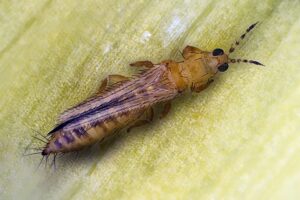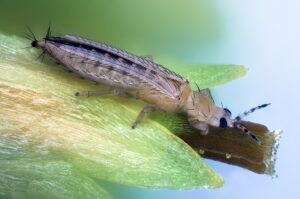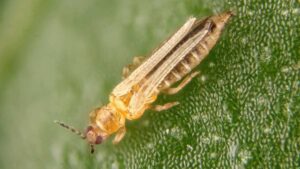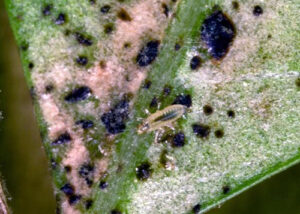Western Flower Thrips (Frankliniella occidentalis)
Updated on
17/11/2022The western flower thrips are a pest species known for their voracious appetite. They cause damage by feeding on various parts of the plants, laying eggs in the tissue of their hosts, and by carrying and infecting the plants with diseases.
Scientific Classification
- Class:Insecta
- Order:Thysanoptera
- Family:Thripidae
- Genus:Frankliniella
- Species:F. occidentalis
Conservation Status
Description
Compared to female thrips, males are rarer. Females are about 0.06 inches long and are slightly larger than males, who are 0.05 inches long. The two can be distinguished from the size of their abdomens – males have narrow abdomens while females are more rounded. Both adults have thin elongated bodies and two wings extending down most of the insect’s body.
The males are yellow, while females can have different colors, such as dark brown, red, or yellow.
Distribution: Native – Southwestern United States; Invasive – Australia, Europe, and South America
Habitat: Various; alpine forests, lowlands, etc.
Do They Bite/Sting: Yes; however, only occasionally while mistaking brightly colored clothes for a food source. Skin irritation may occur, but no risk of disease transmission.
Lifespan: 28 days
Predators: Cucumeris mites, pirate bugs of the genus Orius
Behavior and Characteristics
Feeding
These insects are attracted to bright floral colors like yellow and blue. They feed on over 500 plant species, including fruits, vegetables, and ornamental plants.
Life Cycle
These thrips reproduce via arrhenotokous parthenogenesis, meaning that the unfertilized eggs will grow up to be male. If a male fertilizes these eggs, they will hatch to become female thrips.
1. Egg Stage
They are about 0.008 inches long, oval or kidney-shaped, and white. The female will lay 40-100 eggs in the tissues of part of the plant. Generally, this will be the flower, but sometimes fruits or leaves can have eggs inside them.
2. Nymph Stage
Nymphs are yellow, with distinct red eyes in their first instar. Before molting, the second instar will become white. This stage lasts for 5-20 days, during which they feed on egg eclosion during the first instar and on newly developed fruit in the second.
3. Pupa Stage
The pupal stage of this insect is yellow.
4. Adult Stage
The life cycle of the western flower thrip is affected by the weather. During hot seasons, it takes place over 12 days, while in colder weather, it may occur for over 30 days.
Damage caused by these insects
Western flower thrips mainly cause damage by oviposition, i.e., laying their eggs inside a host plant. When the fully-grown insects emerge, they leave behind holes and silver-colored segments due to exposure to their saliva.
They are a vector of tomato spotted wilt virus (TSWV). Western flower thrips carrying the disease have increased feeding rates, damaging the hosts more. They also infect plants with impatiens necrotic spot virus (INSV).
How to get rid of western flower thrips
As these insects are attracted to the color blue, blue lights and card material often draw the thrips to sticky traps. Pheromones can also be used to draw them in as well.
Outside of natural predators, biological control options include fungi like Metarhizium robertsii and Beauveria bassiana and mirids like Dicyphus hesperus. Also, eliminating reservoir plants that they are attracted to, like jimson weed, will help to keep potential host plants safe.
Source
soundhorticulture.com, anthura.nl, extension.usu.edu, greenhousegrower.com








